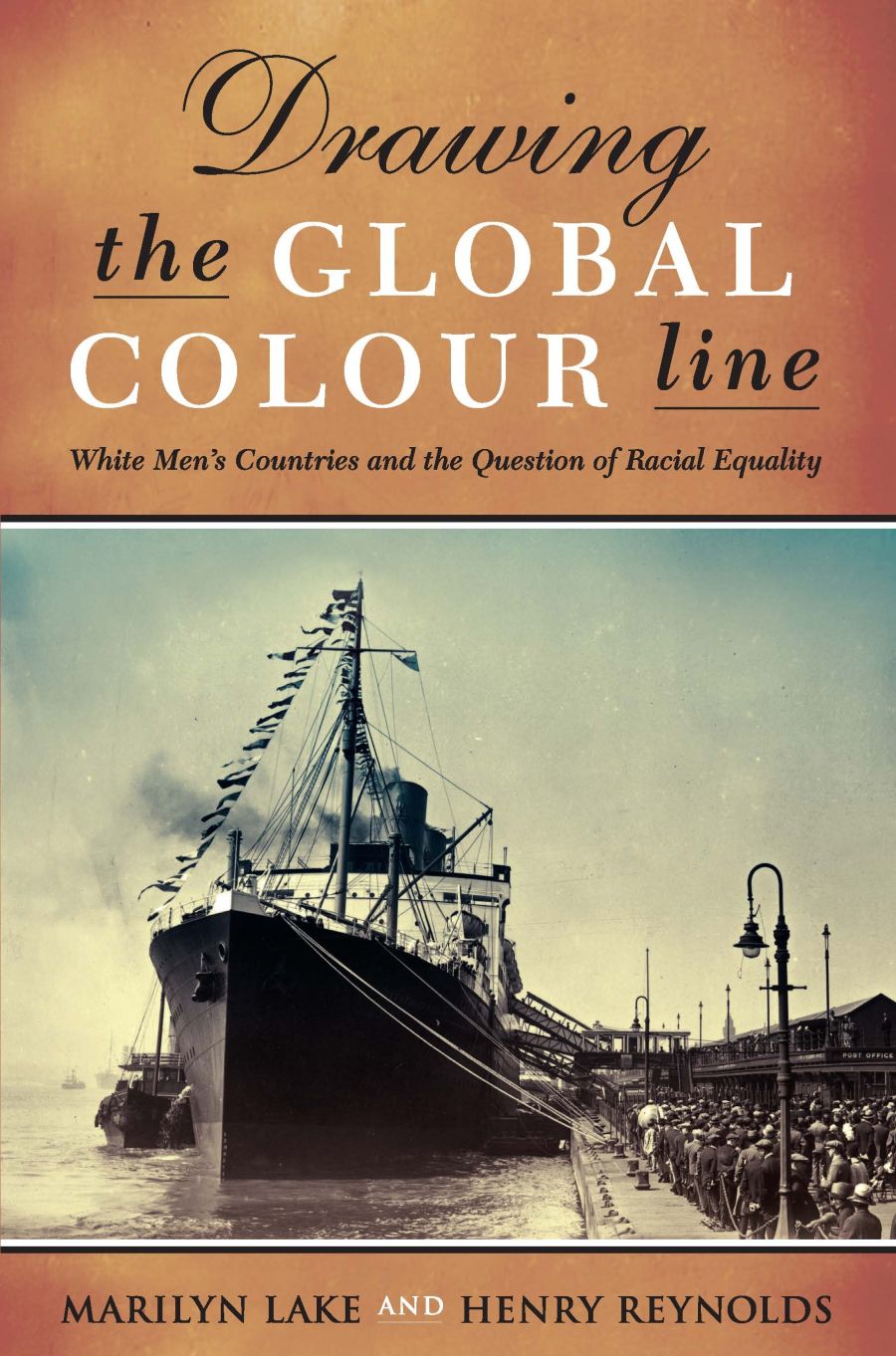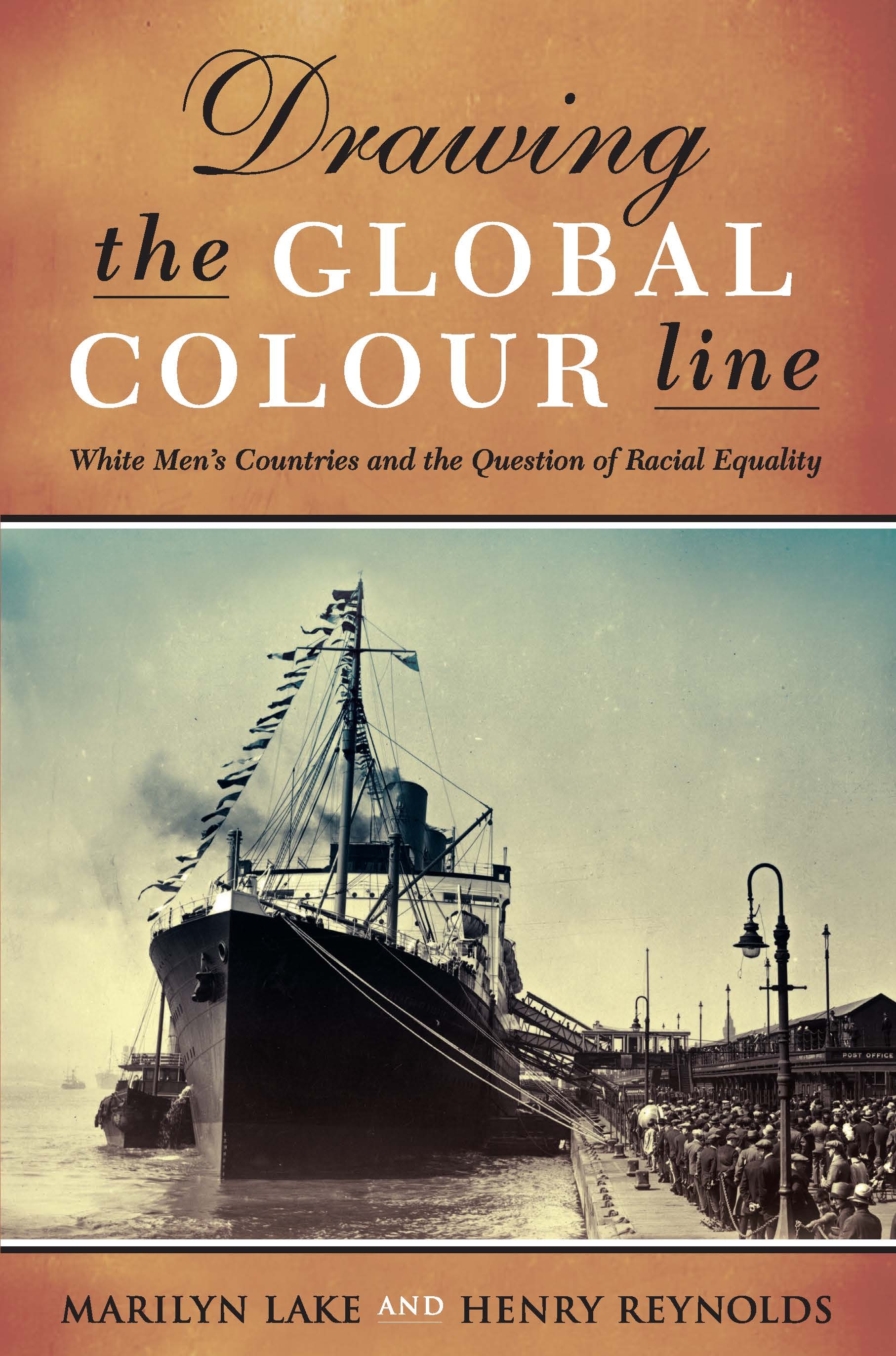
- Free Article: No
- Custom Article Title: Very white men
- Review Article: Yes
- Article Title: Very white men
- Online Only: No
- Custom Highlight Text:
On the front of the only postcard my grandfather kept is a picture of the United States Navy’s ‘great white fleet’ off Australian shores. A Pennsylvanian uncle sent it to the nine-year-old boy in 1908, ‘from one white man to another’. After reading Marilyn Lake’s and Henry Reynolds’s important new book on the transnational assertion of white racial identity in the early twentieth century, I now know that our American relative was merely echoing Rear-Admiral Sperry, who, at a luncheon in Sydney the same year, greeted his Australian hosts as a ‘white man to white men, and I may add, very white men’.
- Book 1 Title: Drawing the Global Colour line
- Book 1 Subtitle: White men’s countries and the question of racial equality
- Book 1 Biblio: MUP, $36.95 pb, 371 pp
- Book 1 Cover Small (400 x 600):

- Book 1 Cover (800 x 1200):

Lake and Reynolds are particularly adept at tracing the Pacific crossings of white men such as Alfred Deakin, Josiah Royce, Charles Pearson and Theodore Roosevelt. They bring to life an international network of intellectuals and politicians, all of them afire with enthusiasm for the white race, keen to discuss the perils it faced and the prospects it might yet enjoy. Mostly, their interactions were confined to the influential salons of New York, Boston, and Melbourne, though occasionally they ventured further afield to more dubious white sites, such as South Africa. It was a genuinely global conversation about race and territorial possession, but, as Lake and Reynolds wryly remark, usually it dwindled into a series of national self-justifications. Thus Australia, the United States, Canada, New Zealand and sometimes South Africa became ‘white men’s countries’, places specially fitted for the exercise of white manly virtues. From such felicitously white places, the indigenous inhabitants were expected to disappear or move aside into dismal enclaves, while other races would be rigorously excluded. In describing this cosmopolitan community of progressive scholars and liberal politicians, Lake and Reynolds have recovered much of the common intellectual framework for policies promoting white Australia and white America.
As the African-American scholar W.E.B. DuBois observed in 1910, ‘the world, in a sudden emotional conversion, has discovered that it is white, and, by that token, wonderful’. In European settler societies across the globe, men became ‘painfully conscious of their whiteness’. Drawing the Global Colour Line – the title refers to another essay by DuBois – is the first historical study of the cosmopolitan dimensions of this startling whiteness. During the past ten years, critical accounts of the invention or construction of the white race have proliferated, but they tend to be circumscribed by national borders. Historians have examined how some people in Australia, the United States and Canada came separately to imagine themselves as white toward the end of the nineteenth century, and continued to proclaim this status for most of the following century. In recognising this novel racial identification as a global project, Lake and Reynolds break new ground.
One of the more striking arguments of this book involves tracing the practice of immigration restriction from the southern Unites States, through South Africa, to Australia and elsewhere. Lake and Reynolds show how the literacy test became an adaptable transnational technology of whiteness, a means of preventing entry of other races to ostensibly white nations. They are less interested in examining the maintenance and purification of whites inside national boundaries, practices that often went by the names of racial hygiene or national hygiene. Yet eugenic concerns about the degeneration of the urban white child prompted the development of other technologies of whiteness during this period, such as the IQ test and sterilisation procedures. A study of the transnational spread of these supplementary measures for population ‘improvement’ also is long overdue. When it arrives it will owe a considerable debt to the pioneering work of Lake and Reynolds.
As with many other innovative studies, it eventually becomes clear that the ambitions of Drawing the Global Colour Line exceed the reach of its authors. Another way of putting this is to say that, like any important book, it opens up an agenda it cannot complete alone. The last third of the book consists of staccato treatments of international race congresses, fears of miscegenation, the rise of Japan, debates at the 1919 Paris peace conference, immigration restriction in the 1920s, the origins of the universal declaration of human rights, and the decline after World War II of white self-assertion. For most of the book, Lake and Reynolds adroitly maintain the coherence of their theme across diverse national sites, but by the end such unison is rare.
Drawing the Global Colour Line gave me a real sense of intellectual excitement. It forced me to reconsider casual assumptions and cherished ideas about the connections of race, nationalism and cosmopolitanism. I wanted to ask Lake and Reynolds to elaborate on the engagement of these self-consciously white men with contrasting notions of republican manhood and imperial destiny. How did whiteness function differently in the domains of nation and empire? In particular, did the emerging American and Australian empires reshape ideals of whiteness once harnessed to republican manhood?
I also wondered whether Lake and Reynolds should have taken DuBois more seriously when he asserted that this precious whiteness was shockingly new. Too often, they seem to confuse cosmopolitan whiteness with an older Anglo-Saxonism, which seems, like the later term Caucasian, to refer to peculiarly North American political debates. (Similarly, Britishness, pertaining to Australian dependency on the mother country, was our local precursor or alternative to transcendent whiteness.) What if whiteness had just that moment been invented as a global identification, with national implications?
Drawing the Global Colour Line provides a history of ideas about race and nation of extraordinary scope and depth, but, as I read it, I was haunted by DuBois’s claim that whiteness represented an emotional conversion. This book shows us a fresh vista of intellectual commitment and interaction, but we learn little about the experience of becoming a real white man. In what way did Deakin and Roosevelt feel white? How did this sense of personal whiteness, this intimate, almost private whiteness, move around the globe? How did ordinary people like young Jack Anderson in Elmore, Victoria, and his uncle in Pittsburgh, Pennsylvania, come to share their intriguing new whiteness?


Comments powered by CComment